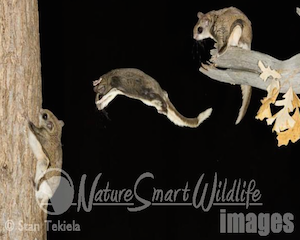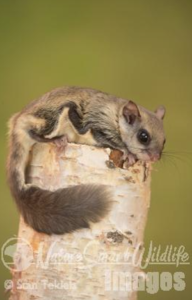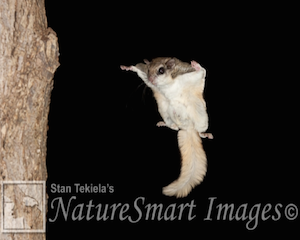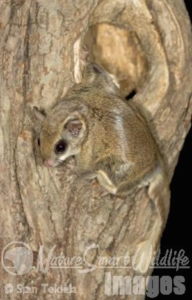
Flying Squirrel—A Mysterious Critter
In today’s NatureSmart column, Stan Tekiela shares with us about flying squirrels.
 I’ve always found the critters that are less well known or more mysterious to be the most fascinating. A good example of this is the flying squirrel. I have recently photographed a wonderful little Southern Flying Squirrel (Glaucomys Volans). There are more than 40 species of flying squirrels in the world, but only 2 species live here in North America. Besides the Southern Flying Squirrel, we also have a Northern Flying Squirrel (Glaucomys sabrinus). In general, the Southern Flying Squirrel lives across most of the eastern half of the country, while the Northern Flying Squirrel lives in the northern states and across Canada.
I’ve always found the critters that are less well known or more mysterious to be the most fascinating. A good example of this is the flying squirrel. I have recently photographed a wonderful little Southern Flying Squirrel (Glaucomys Volans). There are more than 40 species of flying squirrels in the world, but only 2 species live here in North America. Besides the Southern Flying Squirrel, we also have a Northern Flying Squirrel (Glaucomys sabrinus). In general, the Southern Flying Squirrel lives across most of the eastern half of the country, while the Northern Flying Squirrel lives in the northern states and across Canada.
Both the northern and southern flying squirrel are closely related to other tree squirrels. All are in the family Sciuridae. The big difference between flying squirrels and other more familiar tree squirrels is that flying squirrels are nocturnal. All of our other tree squirrels are diurnal and active during the day.
 By some estimates, in the areas where flying squirrels exist, they many outnumber the daytime tree squirrels. Because flying squirrels are highly nocturnal and only become active well after dark, we don’t notice them zipping around the trees under the cover of darkness.
By some estimates, in the areas where flying squirrels exist, they many outnumber the daytime tree squirrels. Because flying squirrels are highly nocturnal and only become active well after dark, we don’t notice them zipping around the trees under the cover of darkness.
Flying squirrels, at 7-9 inches long, are smaller than the common Eastern Gray Squirrel, which is 10-12 inches long. Flying squirrels are only 2-4 oz. in weight, while the Gray Squirrel is more than 1 pound.
Its large bulging eyes are a tip-off to the nocturnal behavior of this little-known critter. In proportion to the size of its head, the eyes are huge. Large eyes allow more light-gathering ability in dark conditions. After all, they need to see where they are going and, more importantly, judge the distance to a landing spot on a tree. Think about it: They are whizzing through a branch- cluttered forest at relatively high speeds in the dark. It is really an amazing feat.
Of course, “flying” squirrel is a bit of a misnomer because they don’t actually fly. Flying implies that they can accelerate and gain altitude at their control. In fact, they just glide on a downward path after leaping off a tree. The process of gliding is proceeded by first identifying a target landing spot. This often involves the squirrel bobbing its head up and down, judging the distance and the path to the landing spot.
 They glide with the aid of a furry, parachute-like skin membrane that stretches from wrist to ankle and is called the patagium. When fully stretched out, the entire body of the squirrel becomes a wing. Even its tail is flat and aids in the gliding and also acts like a rudder to help maneuver around objects and slow down. The fur grows only along the sides of the tail, giving it a flat appearance.
They glide with the aid of a furry, parachute-like skin membrane that stretches from wrist to ankle and is called the patagium. When fully stretched out, the entire body of the squirrel becomes a wing. Even its tail is flat and aids in the gliding and also acts like a rudder to help maneuver around objects and slow down. The fur grows only along the sides of the tail, giving it a flat appearance.
Glides can be upwards of 50 feet in distance, but most are much shorter. Almost always the glide terminates on another tree trunk. When one is about to land, the squirrel pulls up its front legs and lowers its tail to catch some air, like an air-break. They always land head upright, then immediately scamper around to the opposite side of the trunk. Presumably this is a way to avoid any predators, such as owls, that might be following them closely.
Flying squirrels are the most carnivorous of the tree squirrels. In addition to eating seeds, they eat bird eggs, baby birds, small mice, or any dead animal they can find. Insects are also a big part of their diet. Another unusual behavior of the flying squirrel is gregariousness. They live in family units of many individuals in one nest.
 Baby flying squirrels are born in a tree cavity and are naked, eyes closed and helpless. They nurse on mother’s milk, weaning at 5-7 weeks of age. They have several broods of babies each year. Most flying squirrels live only 2-5 years, but some have lived upwards of 10 years in captivity.
Baby flying squirrels are born in a tree cavity and are naked, eyes closed and helpless. They nurse on mother’s milk, weaning at 5-7 weeks of age. They have several broods of babies each year. Most flying squirrels live only 2-5 years, but some have lived upwards of 10 years in captivity.
Some people are lucky to have flying squirrels visit their feeders at night. The squirrels are often not afraid if you turn on a flood light to watch them as they help themselves to your bird seed. Most people fall in love with these cute little critters and can’t wait to watch them visit their feeders each night. Until next time…
If you enjoyed Stan’s post, you may consider one of his amazing nature books: Majestic Eagles; The Lives of Wolves, Coyotes, and Foxes; or Backyard Birds: Welcomed Guests at our Gardens and Feeders. Young readers will delight in his award-winning children’s books, such as Whose Butt?, Critter Litter, and his latest, Jump, Little Wood Ducks.
You can follow Stan on Facebook and Twitter, or contact him via his web page. Stan’s nationally syndicated NatureSmart Column appears in more than 25 cities spanning 5 states (Minnesota, Wisconsin, Michigan, Illinois, and Pennsylvania) and is circulated to more than 750,000 readers. Stan’s author page on Amazon features some amazing videos! Check them out, and follow him for updates.
For more stories about wildlife and nature, sign up for our newsletter now!
More posts from Stan:
Indigo Bunting—A Familiar Summer Visitor
The Nesting Behaviors of Sandhill Cranes
Big Birds, Baby Birds, Birds Everywhere
Stan Tekiela observes Marsh Wrens
The Magical, Mystical World of Sandhill Cranes


